To better understand the ways Americans get their news in the digital age, we surveyed 9,220 U.S. adults from Aug. 31 to Sept. 7, 2020. Everyone who took part is a member of Pew Research Center’s American Trends Panel (ATP), an online survey panel that is recruited through national, random sampling of residential addresses. This way nearly all U.S. adults have a chance of selection. The survey is weighted to be representative of the U.S. adult population by gender, race, ethnicity, partisan affiliation, education and other categories. Read more about the ATP’s methodology.
Here are the questions used for this analysis, along with responses, and its methodology.
This is the latest report in Pew Research Center’s ongoing investigation of the state of news, information and journalism in the digital age, a research program funded by The Pew Charitable Trusts, with generous support from the John S. and James L. Knight Foundation.
Past research by Pew Research Center has tracked the portion of Americans who use social media sites for news. This survey asks about similar topics in a different way (see more details here); because of this, some of these measures cannot be directly compared with past findings. These changes in question wording reflect the Center’s efforts to improve the way we measure news consumption.
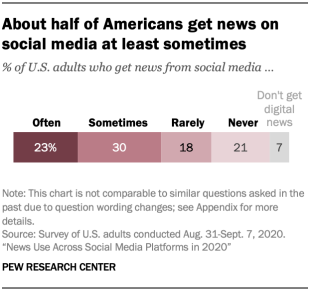
As social media companies struggle to deal with misleading information on their platforms about the election, the COVID-19 pandemic and more, a large portion of Americans continue to rely on these sites for news. About half of U.S. adults (53%) say they get news from social media “often” or “sometimes,” and this use is spread out across a number of different sites, according to a Pew Research Center survey conducted Aug. 31-Sept. 7, 2020.
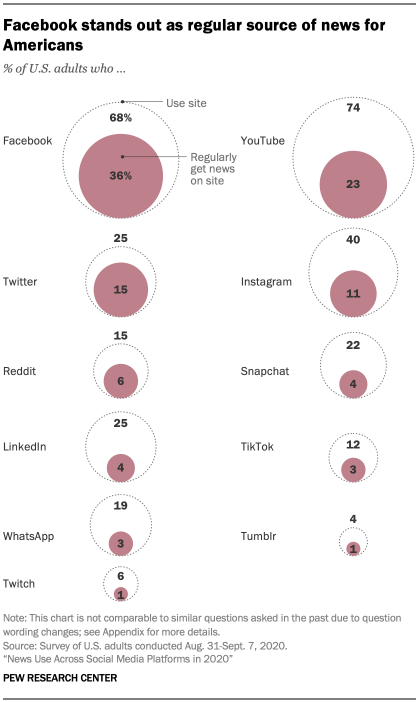
Among 11 social media sites asked about as a regular source of news, Facebook sits at the top, with about a third (36%) of Americans getting news there regularly. YouTube comes next, with 23% of U.S. adults regularly getting news there. Twitter serves as a regular news source for 15% of U.S. adults.
Other social media sites are less likely to be regular news sources. About one-in-ten Americans or fewer report regularly getting news on Instagram (11%), Reddit (6%), Snapchat (4%), LinkedIn (4%), TikTok (3%), WhatsApp (3%), Tumblr (1%) and Twitch (1%).
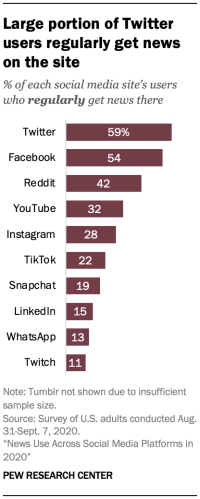
These lower percentages for news use are in some cases related to the fact that fewer Americans report using them at all, compared with the shares who use Facebook and YouTube. If we consider news users as a portion of a site’s overall user base, some sites stand out as being more “newsy” even if their total audience is relatively small. Twitter, for example, is used by 25% of U.S. adults, but over half of those users get news on the site regularly. And 42% of Reddit users get news regularly on the site, though it overall has a very small user base (15% of U.S. adults say they use Reddit). On the other hand, YouTube, though widely used, sees a smaller portion of its users turning to the site for news regularly (32%).
Demographics of regular social media news consumers
There are in some cases drastic demographic differences between the people who turn to each social media site for news. For example, White adults make up a majority of the regular news users of Facebook and Reddit but fewer than half of those who turn to Instagram for news. Both Black and Hispanic adults make up about a quarter of Instagram’s regular news users (22% and 27%, respectively). People who regularly get news on Facebook are more likely to be women than men (63% vs. 35%), while two-thirds of Reddit’s regular news users are men.
The majority of regular news users of many sites – YouTube, Twitter, Instagram, Reddit and LinkedIn – are Democrats or lean Democratic. This may be related to the relatively young age profile of the news user base of these social media sites. No social media site included here has regular news users who are more likely to be Republican or lean Republican.

News on social media sites still seen as inaccurate, as about three-in-ten say it helps them understand current events
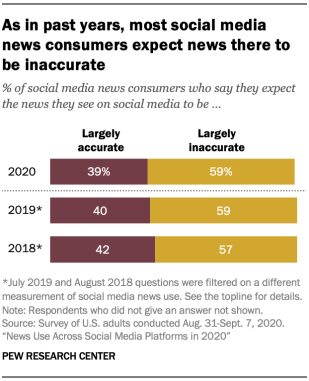
A majority of the Americans who are getting news on social media continue to question its accuracy. About six-in-ten (59%) of those who at least rarely get news on social media say they expect that news to be largely inaccurate, while 39% expect it to be largely accurate. And though there has been increasing discussion of the information on social media, including congressional hearings in 2019 and in 2020, this is not a new sentiment among social media news users: Similar portions have said they expected the news to be inaccurate since 2018.
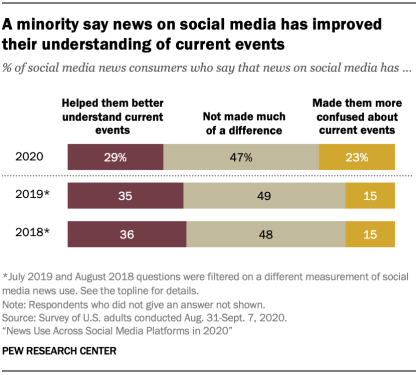
Most Americans do not say news on social media has helped them better understand current events. The largest segment, 47%, says it doesn’t make much of a difference, while 29% say that it has helped their understanding and 23% say it has actually left them more confused. This largely reflects responses to similar questions in 2018 and 2019, when a minority said that social media news helped them better understand current events.